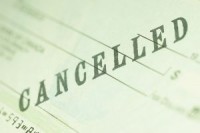
C. Nicholas Pereos, Ltd. v. Bank of Am. (Nev. Supreme Ct. – July 2, 2015)
Williams, a long-time employee of Pereos, Ltd., law firm, was a signator on the firm’s operating account with Bank of America. In September 2006, the firm’s solo practitioner, Pereos, removed Williams as a signator on the account, leaving Pereos as the sole signator. Pereos told Williams to let the Bank of America account “run itself out” to cover any outstanding checks, but he never took any action to affirmatively close the account.
In 2010, Pereos discovered that Williams had been embezzling money since 2006. Despite being removed as a signator on the account, Williams deposited checks made out to Pereos, Ltd. into the Bank of America account and would then write and sign checks for her own personal use. Pereos notified the bank of the unauthorized transactions on January 28, 2010. The next month, Pereos, Ltd. filed a complaint against Bank of America based on Williams’ use of unauthorized signatures to withdraw funds from the account from 2006 to 2010. When it was discovered that Williams had enrolled the Pereos, Ltd. account in online banking and the bank statements had not been mailed, Pereos amended the complaint to include an allegation that Bank of America had failed to make Pereos, Ltd.’s statements available as required by NRS 104.4406(1).
Bank of America moved to dismiss the amended complaint, or alternatively for summary judgment, on the ground that Pereos, Ltd.’s claims for unauthorized transactions were time-barred either because they were not reported by Pereos, Ltd. within 30 days under NRS 104.4406(4)(b) or within the one-year period of repose under NRS 104.4406(6). The bank argued that, notwithstanding Pereos, Ltd.’s contention that the account statements were not mailed to it, Pereos’ deposition testimony revealed that Pereos had on occasion personally picked up some of Pereos, Ltd.’s bank account statements from Bank of America in 2006, 2007, and 2008. The bank attached copies of the account’s statements to its motion and argued that the unauthorized transactions were contained in the bank statements that were made available to Pereos. In opposition, Pereos, Ltd. argued that the statements he obtained were insufficient to provide it with notice of the unauthorized signatures as they were only a single page or two-page document that showed check numbers and the amount of the check, and balances and nothing more. Moreover, he contended that the statements were insufficient because they did not contain a copy of the canceled checks. Pereos also argued that his claims for unauthorized checks cashed within the year preceding his notification to the bank were not time-barred. Conversely, Bank of America argued that, because the same wrongdoer committed all of the wrongful transactions, all claims were time-barred by Pereos, Ltd.’s failure to give the bank notice within 30 days after receiving the account statements.
The district court granted summary judgment in favor of Bank of America, finding that it was irrelevant whether Pereos, Ltd. Received copies of the checks because NRS 104.4406(1) does not require the inclusion of check images. Moreover, the district court found that there was no dispute that the bank statements received by Pereos contained item numbers, amounts, and dates of payment, and thus, the account statements Pereos received were sufficient to notify him of the unauthorized activity on the firm’s account. Accordingly, all claims were time-barred under NRS 104.4406(4)(b) and NRS 104.4406(6). Pereos appealed.
The Nevada Supreme Court explained that Nevada’s version of the Uniform Commercial Code generally absolves a bank of liability for payment on an unauthorized transaction when it provides the customer with information that would allow the customer to identify any unauthorized transactions, such as an account statement, and the customer then fails to timely act in response to unauthorized transactions reflected therein.
